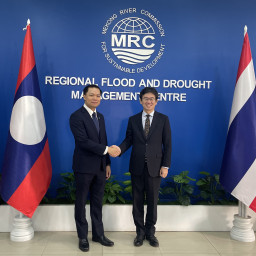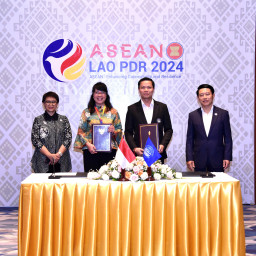Navigation buoys will boost Mekong river trade says Cambodian government
Improving river transport infrastructure will boost trade, cut transport costs and reduce greenhouse gas emissions says the government and Mekong River Commission (MRC), as a programme to improve river navigation between Phnom Penh and Kampong Cham started last week.
"Improving the safety of navigation on this river is vital for the economic development of our country", said Tram Iv Tek, Minister of Public Works and Transport at a recent ceremony to launch the first of 57 buoys and other navigation aids along the 100 km stretch of Cambodian river between the two port cities.
The MRC, which helps Mekong Basin countries manage their water resources, says that currently the river is difficult to navigate. Changes in sedimentation, river depth, water flow and seasonal variations, mean that the river claims dozens of lives per year and reduces the potential river traffic, hitting commerce hard.
"It is essential that we improve the quality of our waterborne transport. By using rivers in a more efficient manner, export potential can improve and this will, in turn, help Cambodia achieve its poverty alleviation goals," said Hiek Phirun, Navigation Programme Coordinator at the MRC. "Properly marked navigation channels in priority stretches of the river will help make Mekong travel less precarious. In the long-term, this will make the use of the river more efficient and help boost trade for Cambodia."
The MRC says that river transport is more efficient than moving goods by road or rail, as well as much more environmentally friendly. For example, on average one litre of fuel can move one ton of cargo 182 km by river, compared to 71 km by rail and 21 km by road. Similarly, river freight produces on average about one fifth of the greenhouse gas CO2 per ton per km that is produced by trucking goods on the road.
The buoys and navigation aids are part of a broader package of activities, funded by the Belgian and Australian Governments, to improve commerce on the Mekong. A system to electronically keep track of shipping, locate and direct vessels in emergencies will also help increase the volume of trade being transported by making boat passage safer and more efficient.
River transport in Cambodia has been hit by the recent downturn in the global economy, falling by approximately 22 percent in the first quarter of this year, compared to 2008. This is a temporary situation and the MRC says that there is still significant potential for increased growth, with the development of new deep sea terminals in Cai Mep, near Ho Chi Minh City that will increase the tonnage being shipped between Phnom Penh and Cai Mep. Using this route, exports from Phnom Penh to the United States or European ports will have only one trans-shipment, at Cai Mep Port
-ends-
Notes to Editors
Present at the event were: Excellency Mr. Sin Niny, Vice Chairman of the Cambodia National Mekong Committee and Member of the MRC Joint Committee; Excellency Mr. Tram Iv Tek, Cambodian Minister of Public Works and Transport; Excellency Mr Rudi Veestraeten, Ambassador of Belgium to Thailand; Excellency Ms. Margaret Adamson, Australian Ambassador to Cambodia, Mr. Jeremy Bird, CEO, Mekong River Commission Secretariat
The Mekong River System presents an excellent opportunity for waterborne transport and trade. This is clearly evident in the delta in Viet Nam, and further upstream on the Mekong stretches bound by the Quadrangle Navigation Agreement near the Golden Triangle. Recent changes in the river morphology favourable to international navigation, economic development and investment opportunities, rehabilitation of the most important ports, improvement of inland waterways, an improved system of aids to navigation, and fast growth of food production, water-related tourism and foreign trade will in the near future require a considerable expansion of the transport capacity of the river.
The MRC is the intergovernmental body responsible for cooperation on the sustainable management of the Mekong Basin whose members include Cambodia, Lao PDR, Thailand and Viet Nam. In dealing with these challenges, it looks across all sectors including sustaining fisheries, identifying opportunities for agriculture, maintaining the freedom of navigation, flood management and preserving important ecosystems. Superimposed on these are the future effects of more extreme floods, prolonged drought and sea level rise associated with climate change. In providing its advice, the MRC aims to facilitate a broad range of dialogue among governments, the private sector and civil society on these challenges.
Photos available on request
For more information
Mr Damian Kean, Interim Communication AdvisorTel: +856 56120695 or +856 21 263 263 Ext. 4703
Email: damian@mrcmekong.org
Mr Khy Lim, Communication Officer
Tel: +856 20 5622 8131
Email: khy@mrcmekong.org




